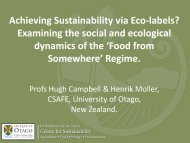Book of Abstract (incl. addendum) - IFSA symposium 2012
Book of Abstract (incl. addendum) - IFSA symposium 2012
Book of Abstract (incl. addendum) - IFSA symposium 2012
Create successful ePaper yourself
Turn your PDF publications into a flip-book with our unique Google optimized e-Paper software.
Workshop 1.3 Understanding agricultural structural changes and their impacts, to support<br />
<strong>incl</strong>usive policy dialogue and formulation<br />
<strong>of</strong> supermarket expansion that hit the West and then spread to Asia and Latin America, this is unlikely<br />
to continue. With a large proportion <strong>of</strong> sub-Saharan African countries’ GDP still heavily reliant on<br />
agriculture, global trends in agrifood business are having an increasing impact on African countries.<br />
South Africa, a leader in agribusiness on the continent, has a well-established agrifood sector that is<br />
facing increasing pressure from various sources, <strong>incl</strong>uding climate variability affecting production, a<br />
global drive towards ‘sustainability,’ certification and the need to support local capacity development<br />
especially in the agricultural sector. Using a socio-ecological systems approach that appreciates both<br />
the environmental and socio-economic drivers <strong>of</strong> change affecting processes in the food system, this<br />
paper situates the future <strong>of</strong> farming systems under these drivers <strong>of</strong> change and looks at how they can be<br />
harnessed to improve the adaptive capacity <strong>of</strong> the food system to an uncertain future. The paper uses<br />
qualitative data from preliminary semi-structured interviews with corporate executives from two South<br />
African food retail companies. Based on this information, the paper draws conclusions regarding how<br />
macro-trends both within and outside <strong>of</strong> the formal food sector are having repercussions for farming<br />
systems. These <strong>incl</strong>ude the recognition that building resilience in the face <strong>of</strong> an uncertain and complex<br />
food system requires a holistic persepctive that capitalises on the system’s diversity and provides a<br />
governance structure that incentivises business to develop strategies that incorporate the needs <strong>of</strong> other<br />
actors.<br />
The industrialization <strong>of</strong> animal agriculture: Implications for small farmers,<br />
rural communities, the environment, and animals in the developing world<br />
Chetana Mirle<br />
Humane Society International, Washington DC, U.S.<br />
Cmirle@hsi.org<br />
The livestock sector is rapidly industrializing, particularly in developing or emerging economies, where<br />
most <strong>of</strong> the growth in meat production is projected to take place (OECD-FAO, 2011). Approximately<br />
80 percent <strong>of</strong> the growth in this sector is already in the form <strong>of</strong> industrial farm animal production<br />
(Steinfeld et al, 2006). Worldwide, industrial systems account for approximately two-thirds <strong>of</strong> egg and<br />
poultry meat production and over half <strong>of</strong> pork production (FAO, 2007), with developing countries<br />
producing approximately half <strong>of</strong> the world’s industrial pork and poultry (Steinfeld et al, 2006a). At the<br />
same time, there is increasing consolidation <strong>of</strong> holdings in the farm animal sector (Steinfeld et al,<br />
2006b; FAO, 2009). Between 1980 and 2000, global pork production nearly doubled, with a decrease<br />
in the total number <strong>of</strong> farms and an increase in larger facilities raising 1000 or more pigs (Cameron,<br />
2000). In India, six large poultry companies account for nearly 40% <strong>of</strong> the egg industry (Rattanani,<br />
2006). In addition to such concentration, farm animal production is becoming geographically clustered<br />
(FAO, 2009). Between 1992 and 2001 the proportion <strong>of</strong> pigs housed on 5% <strong>of</strong> Brazil's land area rose<br />
from 45% to 56% (Steinfeld et al, 2006). It is important to evaluate these trends for impacts on social<br />
and development goals. For example, a 2010 study found that animal agriculture alone will help push<br />
the planet to the brink <strong>of</strong> several sustainability boundaries (Pelletier & Tyedmers, 2010). Industrial<br />
animal agriculture has been shown to threaten the environment due to waste management challenges<br />
(Pew, 2008) (U.S. EPA, 2003). The economic concentration in the farm animal sector been shown to<br />
push small farmers out <strong>of</strong> the market and reduce employment opportunities (McLeod et al, 2009, Ikerd,<br />
2004). This paper will analyze peer-reviewed studies, government data, and industry reports in order to<br />
better understand the impact <strong>of</strong> these structural changes on environmental sustainability and household<br />
food security in developing countries.<br />
28











